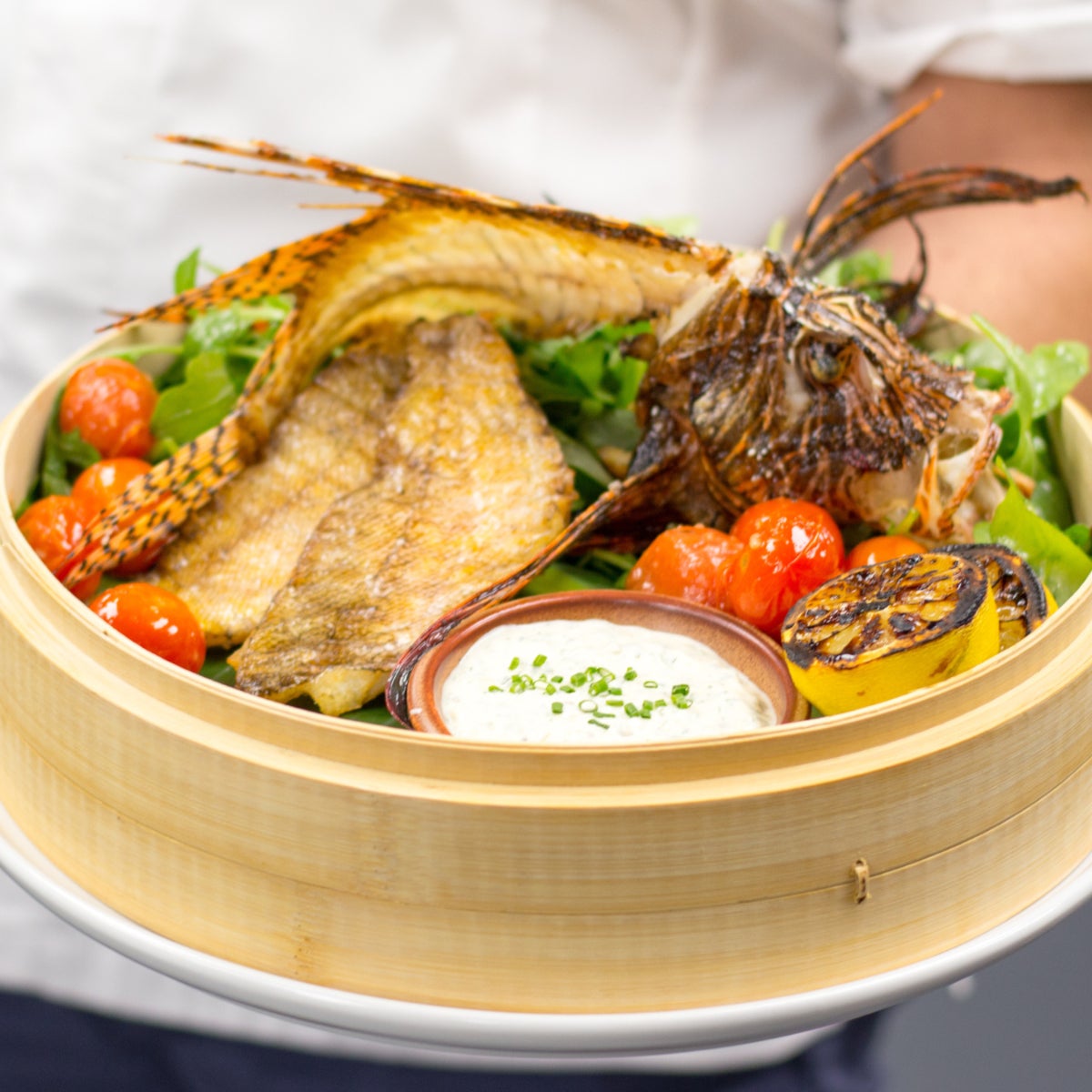Sea turtles, burrowing owls, ocelots, and manatees are bordering on dangerously low numbers, but invasive species—Burmese pythons, European starlings, feral hogs, and lionfish—are populating in out-of-control numbers. Consider the emerald ash borer, a glittery insect native to Russia, China, and Japan that started popping up in Michigan in 2002, destroying ash trees in their wake. It’s hypothesized that the species hitched a ride on cargo ships carrying lumber, and, since then, millions of ash trees have been destroyed in the U.S.
Approximately 6,500 nonindigenous species are in the U.S., posing risks to native plants, animals, and ecosystems—but 37 of those species are edible. While it won’t help solve the problem outright, consider putting these four animals on the menu for your next meal.
Asian Carp
Chef Philippe Parola is one of the biggest proponents of eating invasive species; his boasts his favorite phrase: “Can’t Beat ‘Em, Eat ‘Em.”
Parola moved from France to New Orleans in 1981, working as a chef and restaurant consultant. In 2009, he encountered Asian carp while filming an episode of Jeff Corwin’s Extreme Cuisine. “We were out in the water and these fish started jumping—two landed in the boat,” he says. “They were like 30 pounds a piece, unbelievable. I’ve cooked many species of fish in my lifetime, but never seen those fish.”
Parola quickly learned about the destruction Asian carp have been causing in the south since the 1970s. Originally imported to the U.S. to clean ponds and wastewater facilities, the fish escaped and wound up in the Mississippi River. While they do tend to leap out at unsuspecting fishermen, damaging boats and even noses, their appetite is the biggest problem. Asian carp have few predators and multiply like crazy, devouring huge amounts of plankton, plants, and snails. This leaves very little food left for the native species.
In 2018, Parola began Silverfish Group, Inc., a facility that processes Asian carp to be made into crab cake patties.. “Very few people are going to catch Asian carp, skin them and cook them,” he says. “People need things that they can easily prepare at home.” He likens the taste to dark turkey meat. While the pandemic halted some progress, Parola intends to start the facility back up this year. “You’re minimizing the threat and bringing clean food to the table,” Parola says. “We can make a difference and minimize the threat to the ecosystem.”
Feral Hog
Texas has 4 million wild hogs directly competing for resources against native wildlife like ground-nesting birds. These hogs can grow up to 400 pounds and also wreak havoc on farmers’ crops, digging for insects and roots.
Jesse Griffith, owner of the restaurant Dai Due in Austin, Texas, has been hunting for around 15 years, including feral hogs. “What was appealing to me was how sustainable they were and how misunderstood they were as a food source,” he says. “I come from a background where I learned how to butcher domesticated hogs and couldn’t understand why hogs were being killed and just thrown away.”
After he opened Dai Due in 2006 and started offering hunting guides and classes on cooking game, Griffith began to get a lot of questions about feral hogs. He collected all these inquiries and wrote a book on the topic, .“Often I’m asked what my favorite recipe is to make with feral hog, which is sort of a laughable question because you could be talking about a three-pound piglet or 400-pound hog,” Griffith says. “They’re a hard animal to just cook under a blanket preparation.”
Griffith also battles misinformation surrounding feral hogs. Over the years, he’s heard a variety of false statements, including the belief that you have to soak feral hog in bleach. “That’s news to me, because I eat it all the time,” Griffith says, laughing. “In fact, I serve them constantly at the restaurant. There’s absolutely nothing wrong with it.”
It’s not just hunters who can help. Consumers can purchase game from places like and seek out feral hog in their local restaurants. “It’s important for the consumer to remember they have a say in this too,” Griffith says. “Even just by voting with their dollar or their fork, as they say, they can help.”
Kudzu
Kudzu is an exotic vine that looks similar to poison ivy and is prominent across 227,000 acres of U.S. southern forests. The plant is harmless to people but strangles landscapes with overgrowth strong enough to uproot trees, decreasing overall biodiversity in forests.
The vine was initially brought to the U.S. from Asia in 1876 for homeowners to use as shade for porches. In the 1930s, the Soil Erosion Service (later renamed the Soul Conservation Service) gave 85 million kudzu seedlings to farmers and landowners across the south to combat soil erosion. There was even a monetary reward for farmers who covered their farms with it. In 1970, the USDA listed it as a noxious weed in 13 states.
For centuries, Chinese medicine has been incorporating kudzu into herbal practices to treat heart disease, fever, and even the common cold. Chef Sean Brock, previous owner of popular Charleston, South Carolina, restaurant Husk, grew up in Wise County, Virginia, where kudzu is abundant. “I first used kudzu in cooking back in 2009,” Brock says. “The root produces the best thickening agent for sauces and it helps create a creamy texture that doesn’t affect the flavor of the sauce. It’s misunderstood because it’s a pain in the butt. We pay as much as $40 for a pound of starch from Japan, yet here we are sitting on a goldmine.”
The vine’s mild spinach flavor absorbs other tastes well, making it a seamless addition to almost anything: kudzu quiche, kudzu chicken, kudzu soup, and kuzu cocktails.
Lionfish
Lionfish, native to the Indian Pacific ocean, wound up along the southeast coast of the U.S., the Gulf of Mexico, and the southeast coast of the Caribbean thanks to exotic pet owners— experts suggest people have been dumping lionfish into wild waters from home aquariums for 25 years after finding them difficult to take care of.
Omar Olsen, chef at at Delray Beach in Florida, used to spearfish for the fish daily with his diver friends. “With their carnivorous nature and lack of natural predators, lionfish eat all sea life species,” Olsen says. “More importantly, they devour the natural reefs, including the crustaceans that dwell there.” Now, he serves the fish at his restaurant with charred lemon, blistered tomatoes, arugula salad, and Bagna Cauda.
Carlos Reina initially discovered lionfish when preparing for the S. Pellegrino Young Chef Academy, a global talent search to find the best young chefs in the world. Once its venomous spines are removed, the fish has a delicate, flaky, and buttery texture. “The flavor of the meat is very concentrated and pairs very well with citrus such as lemon, lime, grapefruit, wine, garlic, lemongrass, ginger, tarragon, and, of course, moringa,” Reina, now sous chef at Renaissance Wind Creek Aruba Resort, says.
Olsen prepares lionfish by scaling and carefully fileting it, preserving the skeletal body. He then seasons and dusts the meat before frying it. “We serve filets along with the skeletal body fried for a ‘wow’ factor presentation,” he says. “It’s different from preparing other fish due to the venom that remains in the barbs. We carefully trim those. Cooking the fish deactivates the venom.”


